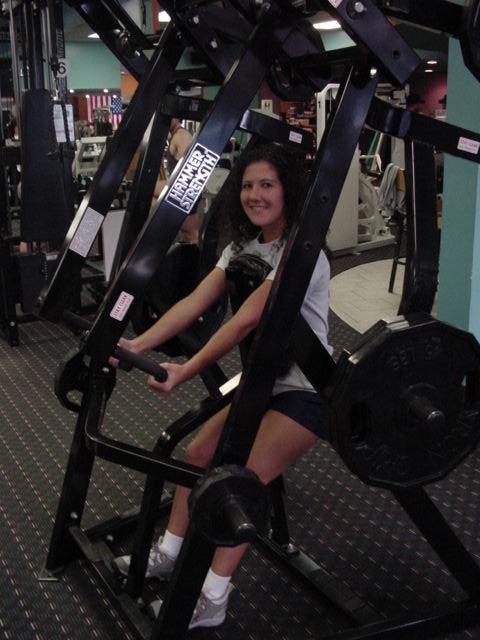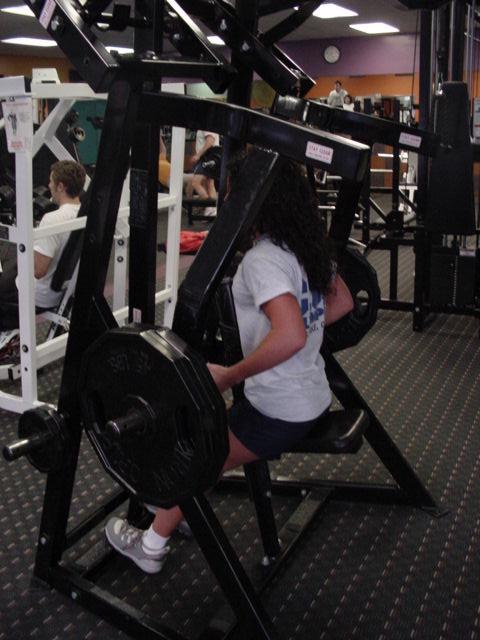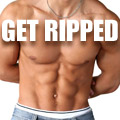Q&A with Michael Furci - Benefits and side effects of Creatine; lower back exercises and evaluating gyms
07/02/2002
Furci Home / Fitness Channel / Bullz-Eye Home
Q: Mike,
I've just begun recently working out after a hiatus due to school. I had a couple
questions I wanted to hear your thoughts on:
1) What do you think of creatine and its effectiveness/usage?
2) What are your opinions about the body getting dependant on artificial production
due to use of supplements like creatine and Tribex, etc?
3) My main focus in my workout is to try to take care of my upper chest, since
it just seems to slope out as it goes down. I read your perfect pecs article,
but when I do similar exercises for my inner chest, it doesn't feel like it's
taking care of it. What can you suggest to take care of that part of my workout?
Thanks for your time,
Parhaum, T.
Baltimore, MD
A: Parhaum,
T.
Creatine is probably the most studied supplement there is. It came under fire
a few years back with concerns about dehydration and cramping. These concerns
were put to rest after many researchers found no link between creatine and dehydration
among athletes. After literally hundreds of studies there appears to but no negative
side effects associated with creatine usage.
What many people don't know is that creatine is found naturally in the food we
eat. It is found in high levels in red meat. As a matter of fact, this is the
main reason why people who eat red meat regularly don't seem to get good results
with the supplementation of creatine. Creatine does, however, yield great results
for most people.
Creatine will work very well for about 30 to 40 percent of the people who use
it. Another 30% of the people who use it will claim good results. But unfortunately,
about 30% of all creatine users report almost no effect at all. Many of these
people may be getting it in their diets.
When taking creatine, use 20 grams per day for the first seven days as a loading
phase. Do you need to load up? No, but your muscles will reach their saturation
point quicker. After the loading phase, use 10 grams a day for five more weeks.
Take the next three to four weeks off, and start again.
Creatine hit the market about 10 years ago. Since then it has been the most popular
sports supplement of all time. This is because of one reason -- it works.
Creatine works by giving the muscle cell what it needs to store ATP (Adenosine
Triphosphate). ATP is the energy source our muscles use for heavy-duty short-term
workloads, the type used in weight training. Creatine has been shown to increase
strength in most people by 10%. Endurance athletes will find the use of creatine
to be a waste of time because it does not affect that energy system.
Your second question is interesting. I've only heard this maybe two other times.
Does the body get dependant on artificial production? No. If you take supplements
like Tribex, creatine or whatever in the manner they were intended, your body
will go right back to where it is genetically supposed to be. Studies have shown
that even those who take anabolic steroids for extended periods of time (longer
than a year), once they got of the drugs their bodies returned to functioning
normally.
I seem to be getting a lot of chest development questions over the last six months,
so you are definitely not alone. I've said and written it hundreds of times and
I'll write it again: You cannot change the shape of a particular muscle. You
can make the muscle bigger, and you can make it smaller, but the basic shape
will always remain. If we could change the shape of our muscles, every body builder
would have huge peaked biceps and thick Arnold-like chests. I don't care what
you've read or whom you hear it from. There are no magical exercises out there.
If you've tried different angles, exercises and workouts and still notice no
significant difference, than you probably are never going to have a big upper
chest. Learn to take what you have and run with it. We all want what we don't
have.
When I started to get interested in bodybuilding, I wanted arms like Arnold.
But then again, who doesn't? Anyway, for years I was hell bent on getting that
22'' arm. After five years of serious training and learning about the physiology
of the body I realized that a 22-inch bicep was not in the cards for me. This
realization, however, did not stop me from trying to have the best arms I could.
I'm still trying, by the way. Do not get discouraged that you're not going to
have a chest like Arnold's. Start looking at improving what you have. Use Arnold
as motivation, not a goal.
Q: Hello
Mike,
Great article on abs, real good stuff. Can you recommend any stuff for lower
back? I recall that with opposing muscle groups you really have to watch for
a balanced strengthening. I should think that this would be especially important
with the abs/lower back. I am mainly doing supermans, floor hyperextensions and
hyperextensions on the stability ball. Once I'm well into that then it's on to
deadlifts. Any other ideas?
Thanks,
Steve
A: Steve,
First let me thank you for the compliment.
What you are doing for your lower back is an excellent way to increase strength
and stability. The only thing I could see adding would be weight while performing
stability ball hyperextensions. Hold a dumbbell or a plate with your arms extended
in front of you. This is a great way to add progressive resistance to this exercise.
But remember, without strong abs your lower back, no matter how strong it is,
will remain a weak point. It is your abdominal wall that produces intra-abdominal
pressure against the anterior (front) surface of the spine. It is this pressure
and proper form that keep the spine safe.
Q: Hi,
I recently moved into an apartment complex that has a small gym.
By small I mean they have a bike, treadmill, one of those other
machines (can't remember the name of it) and a small combo weight
machine. It has a chest press, pull down and a couple of other
things to do too. It's all cable and weight, if that helps. My
question for you is this: I want to use this gym because I can't
afford a real gym right now and I would like to know if you have
any type of workout regimen or system for using these small gyms.
Thank you,
Brett
Houston, Texas
A: Brett,
Fitness areas in apartment complexes are becoming commonplace. There are two
problems I see with almost all apartment fitness areas. One, there isn't anybody
who is qualified to help put the tenants on a program. And two, these fitness
areas are usually worthless. Just like the tennis courts and the occasional basketball
area, fitness areas are used as a selling tool. The management knows this is
an inexpensive way to add value to charge higher rent. I drive by apartment complexes
almost daily and almost never see anyone using the tennis courts or basketball
hoops. Even less people use the fitness areas.
My question to you is how serious are you about working out? I've heard your
excuse from many different people over the years. "I can't afford a real
gym right now." This is as bad as, "I just don't have the time." You
mean to tell me, Brett, that you can't afford $20.00 to $40.00 a month, which
is what an average gym membership will cost? You don't have the money because
it's not a priority in your life. If $20.00 to $40.00 a month were all it cost
to have your way with a different Penthouse Pet each week, I guarantee you'd
come up with the money.
My advice to you is to make a commitment to being fit and join a gym. A good
gym offers motivation, education, equipment and a great atmosphere. The average
person lacks greatly in motivation anyway, and an apartment complex fitness area
is just not going to cut it.
Q: What
is a D. Y. Row?
A: A
D. Y. Row is a piece of back equipment made by Hammer Strength.
It is named after one of the most successful bodybuilders of
all time, Dorian Yates. Dorian became known for doing reverse
grip bent-over rows. He used an incredible amount of weight,
sometimes upwards of 500 lbs. Dorian had arguably the best back
of any bodybuilder ever. Since he was one of the few bodybuilders
doing bent-over barbell rows, many attributed his outstanding
development to this movement. Hammer Strength made the D. Y.
Row to simulate the movement of a reverse grip bent-over barbell
row. The D. Y. Row, although one of the best pieces one can use
to increase the development and strength of their back, should
not replace doing free-weight movements.


Got a question for Mike? Send it to mike@bullz-eye.com.
You can follow us on Twitter and Facebook for content updates. Also, sign up for our email list for weekly updates and check us out on Google+ as well.







